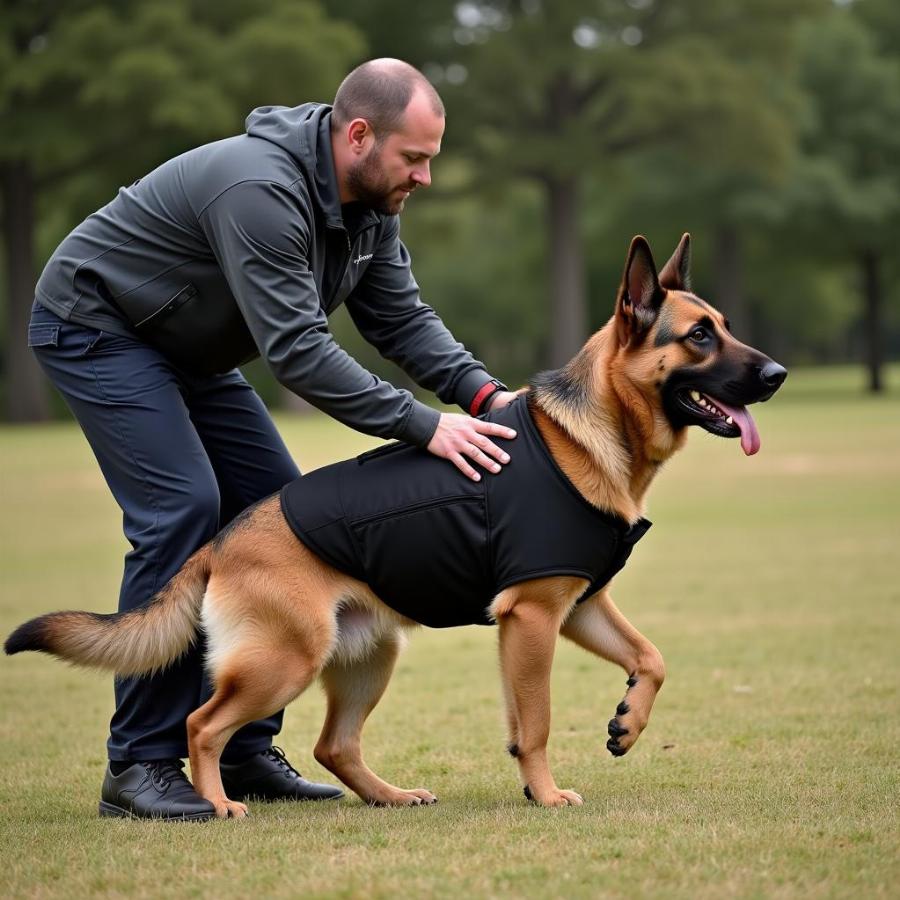Dog protection training, often misunderstood, is about far more than teaching your canine companion to attack. It’s a comprehensive approach that fosters a deep bond between you and your dog while equipping them with the skills to react safely and appropriately in various situations. This training focuses on developing your dog’s obedience, confidence, and ability to differentiate between genuine threats and everyday encounters.
 Dog Protection Training Session
Dog Protection Training Session
Unveiling the Principles of Dog Protection Training
Contrary to popular belief, dog protection training isn’t about creating aggressive dogs. Instead, it’s about instilling discipline, control, and predictable responses. A well-trained protection dog is not only a deterrent to potential threats but also a reliable companion that can provide a sense of security.
Choosing the Right Dog for Protection Training
While any breed can benefit from basic obedience training, certain breeds possess innate traits that make them well-suited for protection training. German Shepherds, Belgian Malinois, and Rottweilers are known for their intelligence, loyalty, and natural guarding instincts, making them popular choices. However, it’s crucial to remember that breed alone doesn’t guarantee success; temperament, drive, and early socialization play equally significant roles.
Finding a Qualified Trainer
Dog protection training is not a DIY endeavor. Seeking guidance from a qualified and experienced professional is paramount. Look for trainers with certifications from reputable organizations, a proven track record, and positive training methods. A good trainer will prioritize your dog’s well-being, utilize humane techniques, and tailor the training to your dog’s specific needs and abilities.
Key Elements of Dog Protection Training
Dog protection training encompasses a range of exercises and techniques, each designed to enhance your dog’s obedience and controlled responses:
1. Obedience Training: The Foundation
Solid obedience training forms the bedrock of dog protection training. Before your dog can learn advanced protection skills, they need to master basic commands like sit, stay, come, and heel. These commands provide the foundation for control and ensure your dog responds reliably, even in stressful situations.
2. Socialization: Building Confidence and Discernment
Early and ongoing socialization is crucial for any dog, especially those undergoing protection training. Exposing your dog to various people, environments, and stimuli helps them develop confidence and learn to differentiate between genuine threats and benign encounters. This discrimination is essential to prevent your dog from reacting inappropriately.
3. Bark and Hold: Controlled Deterrence
The “bark and hold” technique teaches your dog to bark at a perceived threat while maintaining a safe distance. This controlled response serves as a deterrent without escalating to physical contact. The dog learns to alert you to potential danger while awaiting your further instructions.
4. Controlled Aggression: A Last Resort
Teaching controlled aggression is a sensitive aspect of protection training and should only be conducted under the guidance of a highly experienced professional. This aspect focuses on teaching the dog to use controlled force as a last resort to protect themselves or their handler if a threat escalates.
The Importance of Ongoing Training and Reinforcement
Dog protection training is not a one-time event; it’s an ongoing commitment. Consistent practice, reinforcement of learned behaviors, and regular refreshers with a qualified trainer are crucial to maintain your dog’s skills and ensure they remain responsive and reliable.
Conclusion
Dog protection training, when approached responsibly and ethically, can be a valuable tool for enhancing your dog’s obedience, confidence, and ability to react appropriately in challenging situations. Remember, the goal is not to create an aggressive dog but a well-adjusted companion capable of providing both companionship and a sense of security. By investing in professional training and committing to ongoing practice, you can foster a strong bond with your canine companion while equipping them with the skills to navigate the world safely.
FAQs about Dog Protection Training
1. What age should I start dog protection training?
While basic obedience can begin in puppyhood, formal protection training is typically best suited for dogs at least one year old, once they have developed physically and mentally.
2. Is my dog breed suitable for protection training?
While certain breeds are predisposed to protection work, any breed can benefit from basic obedience and some aspects of protection training. Consult with a qualified trainer to assess your dog’s suitability.
3. How long does dog protection training take?
The duration of training varies depending on the dog’s individual aptitude, the complexity of the skills being taught, and the owner’s commitment to practice. It can range from several months to a year or more.
4. Can I do dog protection training myself?
Dog protection training requires specialized knowledge and experience. Attempting to train your dog yourself without proper guidance can be dangerous and counterproductive. Always seek professional help.
5. Is dog protection training cruel?
When conducted by a qualified and ethical trainer, dog protection training utilizes positive reinforcement methods and focuses on building a strong bond between the dog and handler. It should never involve cruelty or abuse.
Need more guidance on dog protection training or other aspects of responsible dog ownership? Contact Beaut Dogs at [email protected] for expert advice and tailored information.
Beaut Dogs is your ultimate resource for all things dog-related, providing reliable and insightful information on various breeds, care tips, training advice, and more. Visit us at https://beautdogs.com to explore the wonderful world of canine companions and learn how to provide the best care for your furry friend.